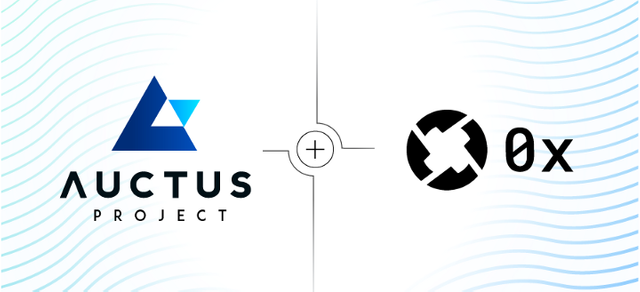Auctus Announces 0x Protocol Integration

An example of pension fund decentralization
Following up on our previous post about decentralized exchanges and on our development update, in this post we want to describe the options available to convert the contributions collected by the Auctus platform, into tokenized assets where pension funds will be invested in, focusing on the use of the 0x protocol.
The need for a decentralized exchange protocol
One of the main requirements for the Auctus platform is to accept deposits made by employees, corresponding to the contribution of their pension funds. The development roadmap for the Auctus project includes a future fiat payment gateway integration, but for the first smart contract-based pension fund released as a proof-of-concept, contributions can be collected in ETH or other ERC20-compliant tokens. After the wide adoption of Tether.to’s Bitcoin-based USDTether, Tether and Ethfinex have recently announced the development of the first Ethereum-based Tether, compatible with the ERC20 standard. This initiative allows contributions to be collected with traditional currencies across the blockchain, without the volatility of cryptocurrencies.After collecting contributions through smart contracts, the Auctus platform needs to trade the currency collected for the tokenized assets that compose the pension fund portfolio. An approach involving centralized exchanges would have many disadvantages. Human intervention would be necessary to register and verify accounts in multiple exchanges (according to available tokens in each one) and we would be at the mercy of a centralized entity that would be in control of the funds during the time needed to deposit, trade and withdraw. Those are just a few examples of the problems, but we could also add to the list higher fees, less transparency to the pensioners, more time needed to complete the process and so on. We are aiming at a decentralized approach and until this moment, our development team has been studying the 0x protocol and has been keeping an eye on the 0x relayers that are being created.
0x protocol summary
The 0x protocol, as described in their whitepaper, implements an “off-chain order relay with on-chain settlement”. This approach combines efficiency (low cost for market makers) and fast settlement. Cryptographically signed orders are broadcast off of the blockchain and market takers can execute these orders in a trustless way using on-chain smart contracts.Currently, there are different decentralized exchange solutions being built (or operating) with no standards, and the 0x protocol aims to be a common building block to allow dApps to be built upon it, without the need to always reimplement the exchange functionalities every time.There are also different approaches for trading tokens, such as the Bancor Protocol, which is an automated market maker that enables tokens to be instantly purchased or liquidated directly through the smart contract, without the need to find an interested counterparty (the protocol uses price-adjustment formulas to set the price). One problem with this kind of approach is that it creates artificial constraints and the price changes depend on the sensitivity of the model used. However, the fact that there is no need for a counterparty to fill an order is a great advantage. Different approaches could also be implemented with the 0x Protocol, as described next.
0x Relayers: Liquidity Pools for tokenized assets
Relayers are entities that aggregate orders from buyers and sellers and provide public order books. Market participants don’t need to trust the relayers, as the orders are signed by market makers and executed by market takers. The relayers can’t execute orders on behalf of participants. Instead, they merely facilitate orders hosting and propagation.There are already some teams building relayers on top of the 0x protocol. At the moment of the writing of this post, we know about Ethfinex, Kin Alpha,Radar Relay and The 0cean. These relayers might provide the liquid markets we need to enable the Auctus platform to provide an easy, fast and trustless fund management experience.The relayers that have been announced so far are building order books, but something like an automated market maker could be achieved if an entity decides to act as both relayer and seller, exchanging tokens from its own reserve.
Implementation alternatives
The Auctus platform will provide a tool for creating, customizing and managing pension funds, using the blockchain technology and the security and transparency of smart contracts. Exchange functionalities are out of scope for this project. However, the platform needs a means of trading the currency, collected in contributions, for other tokens that are optimized to be the least expensive and the most automated, secure and efficient possible. We found in the 0x protocol, the tool needed to eliminate the need for implementing trading functions from scratch, or of using centralized solutions.The trading functions using the 0x protocol will be implemented in a decoupled module, separated from the platform’s core and main functions, in order to allow it to evolve independently of the rest. Until the 0x team succeeds on building a global network of relayers and there is an availability of liquidity pools for every kind of tokenized assets, some hybrid solutions using a combination of different relayers, or even hosting our own relayer may be considered. Another alternative to be considered (but difficult to achieve in practice), would be to have a reserve of tokenized assets and use the 0x smart contracts to directly exchange between tokens without a relayer.
Conclusion
The 0x protocol is already being used by several other Ethereum-based projects and this creates a strong community that pushes the protocol to be constantly improved and also enables a greater exchange of information and support among the teams of developers using the protocol. The Auctus platform is being developed in a way that it can soon be integrated to an exchange module that will make use of the 0x protocol, directly, or through relayers.Meanwhile, we welcome you to join Auctus pre-sale whitelist at auctus.organd invite you to follow us on social media.
Hi! I am a robot. I just upvoted you! I found similar content that readers might be interested in:
https://medium.com/auctus/auctus-announces-0x-protocol-integration-e0f842e247d6